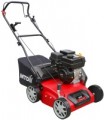Working width
The width of the strip processed by the aerator in one pass. The higher this indicator, the faster the device works, the fewer passes will have to be made to process a certain area. On the other hand,
a wide grip noticeably affects the dimensions of the entire structure and makes it difficult to work in hard-to-reach places, if not impossible. Therefore, when choosing a model in terms of working width, it is worth considering not only the overall dimensions of the site, but also its configuration and the presence of tight areas — sometimes it is preferable to sacrifice the performance of the aerator for the sake of its manoeuvrability and patency.
Number of depth settings
The number of nozzle depth adjustments provided in the design of the aerator. Note that we can talk not only about the depth, but also, in the case of scarifiers, about the height of processing (for more details, see above). Anyway, the
more depth (height) settings, the wider the choice of the operator, the more accurately he can choose the optimal value for a particular situation.
Shaft speed
Rotation speed of the aerator shaft in normal operation.
Manufacturers select the shaft speed in such a way that the device is guaranteed to be able to cope with the tasks for which it is designed. So in most cases, this parameter is more of a reference than practically significant. At the same time, for verticutters (see "Type"), it can also have a practical meaning: lower speed, with the same power, provides higher tractive effort and allows you to better cope with dense soils and thick rhizomes. So for such conditions, it is worth choosing a model with lower revolutions, and for a favorable environment, on the contrary, higher (high revolutions have a positive effect on performance).
Working mechanism
The design of the working mechanism provided in the aerator, in other words, the number and types of working elements installed on the shaft. For verticutters (see "Type") such elements are blades, for scarifiers — spring teeth. For
combined models, in this case, the design of both working shafts is indicated, for example "14 knives / 20 spring teeth".
Bag volume
The total volume of the garbage collection bag provided with the aerator.
The larger the bag, the more garbage it can hold, the less often it will have to be emptied. On the other hand, the weight and dimensions of a capacious container will also be considerable (this is especially true for rigid varieties, in which the size does not depend on fullness — see "Bag Type"). Yes, and carrying too much garbage “with you” is not always convenient, especially with the small size and weight of the unit itself. Therefore, manufacturers, usually, choose this parameter taking into account the specifics of the use of the aerator. So, in low-power models designed for small areas, the volume of the bag is also small, and in high-performance professional devices it can exceed 50 liters.
Handle height adjustment
The ability
to change the height of the aerator handle. This feature makes it possible to adjust the unit to the height of the user in order to ensure comfort and reduce fatigue.
Engine size
The volume of the petrol engine installed in the corresponding type of aerator (see "Engine type"). Usually, the larger the engine (with the same type of internal combustion engine, see above) — the higher its power and the more fuel it consumes. In general, this parameter is for reference: manufacturers select it in such a way as to provide the necessary practical characteristics (in particular, the same power).
Motor power
Aerator engine power expressed in horsepower (hp). In the case of aerators, this unit is used only for models with gasoline engines (see "Engine type"). Note that some time ago, the designation of power in horsepower was standard for internal combustion engines, but now watts are increasingly used for this; so hp is used more as a tribute to tradition than as an urgent need, and most often these data are duplicated in watts. However, even if there is no such duplication, some units can be easily converted to others: 1 hp. approximately corresponds to 735 watts. For more information about the value of engine power, see the paragraph of the same name below.
Motor power
The power of the aerator motor, expressed in watts. Today, the watt is the common unit of power and is used for both electric and petrol models (see "Engine type"). In general, the
more powerful the motor, the higher the performance of the unit, the greater the depth of processing and the working width (see above) can be provided in the aerator; however, the consumption of electricity / fuel also directly depends on the power. Therefore, when choosing an engine for their equipment, manufacturers proceed from a reasonable compromise between these properties, and in general, engine power allows you to evaluate the performance of the unit and its suitability for large volumes of work.

